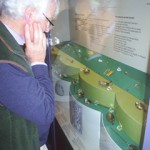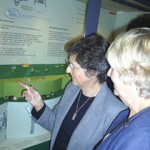Thetford “Treasure” on its way home
From the Watton & Swaffham Times, 31 December 2007:
It is one of East Anglia’s most significant treasures, but rested underground for more than 1,500 years and was promptly whisked away to London following news of its discovery.
But part of precious hoard of Roman gold jewellery and silver spoons that was uncovered at a Thetford industrial site nearly 30 years ago is set to return to its home town for the first time. The Thetford Treasure – one of the country’s greatest archaeological finds of the 20th century – will leave the British Museum in early May for a six month secondment to a 500-year-old town house.
The loan of almost half of the priceless collection of gold bracelets, necklaces, pendants, rings and silver spoons and strainers, dated between 380 and 390 AD, represents a major coup for Ancient House Museum of Thetford Life.
The museum, in White Hart Street, has about 30 replicas of the Thetford Treasure on display, but will get to exhibit the real thing to the public from May 12, 18 months after a top-to-toe refurbishment of the Tudor building.
The beautiful 83-piece collection, which was found in superb condition in the Gallows Hill area of Thetford in 1979, revealed a lot about life and religion at the end of the Roman era in Britain in the late 4th century. It might not be quite on the scale of world renowned touring exhibitions such as King Tutankhamun or China’s terracotta warriors, but officials from Norfolk Museums and Archaeology Service are buzzing with excitement after striking a deal to get 35 pieces of the Thetford Treasure from the British Museum’s Partnership UK scheme.
Oliver Bone, curator of Ancient House, said the loan, which will include some of the British Museum’s most prized objects, such as a gold buckle featuring a dancing satyr and some of the finer engraved silver spoons, would not have been possible before the Thetford museum’s £1.6m renovation.
“We are very pleased and it is quite a privilege to borrow something like the Thetford Treasure. The refurbishment has enabled us to receive loans from national collections because we can now protect our objects better and the environment is better.
“The Thetford Treasure is of national and international importance because of what it tells us about the belief system towards the end of the Roman period. The finds are very interesting and the craftsmanship is particularly high. The gold is very soft and pure, but it does not have any wear marks,” he said.
The hoard of flamboyant bracelets, necklaces, pendants and rings, many of which are bejewelled with precious stones, and 33 silver spoons, which were made in either France or Britain in the late 4th century, were found in a shale box on what is now Fison Way industrial estate, in Thetford, by Norwich metal detectorist Arthur Brooks in November 1979.
Unfortunately, he held on to the Roman collection for six months before declaring it, denying archaeologists the opportunity to excavate the area and possibly find more of the collection. Mr Brooks, who died before it was declared treasure trove in 1981, was awarded £87,180 of the £261,540 compensation he would have been entitled to had he declared the find straight away. It is rumoured that hundreds of gold and silver coins at the former Roman settlement have never been discovered or declared by Norfolk’s metal detecting community.
Many of the engravings on the spoons of the Thetford Treasure testify to the continued worship of ancient pagan god Faunus when Christianity was the official religion of the time. Remarkably, the gold jewellery was never worn and is thought to have been buried for safe keeping because of considerable unrest in East Anglia at the time with attacks from Saxon pirates and sustained opposition to pagan religious cults.
The Thetford Treasure, which will be featured in Ancient House’s new changing exhibition space, will also sit alongside Roman objects from the Castle Museum in Norwich, which came from archaeological finds at Hockwold, near Thetford, and Brampton, near Aylsham.



